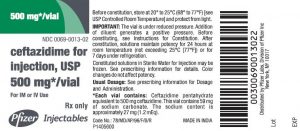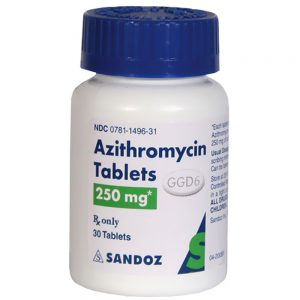Contents
Azithromycin
Azithromycin is an antibiotic that is used for the treatment of variety of bacterial infections such as skin, ear, respiratory infections and sexually transmitted diseases (STDs).
The drug is available under generic name Azithromycin and marketed under the various brand names such as Zithromax, Azithrocin and Azyth. Pfizer is accountable for the manufacturing and marketing of Azithromycin. Furthermore, Azithromycin is marketed as an ophthalmic solution under the brand name AzaSite by Inspire Pharmaceuticals.
Azithromycin is a semi-synthetic, relatively broad spectrum, macrolide antibiotic. Azithromycin plays a key role in the treatment of complication related to the bacterial infections such bronchitis, pneumonia, skin infections and infections of ear and throat.
It is also recommended to treat the sexually transmitted diseases and urinary tract infections. It is also used to prevent or treat the disseminated Mycobacterium avium complex (MAC) infection.
Azithromycin (in form of ophthalmic solution) is used to treat bacterial conjunctivitis (a bacterial eye infection). The drug is also prescribed for the treatment of acute bacterial sinusitis caused by H. Influenza, M. Catarrhalis or S, pneumonia.
Sometime it is also used to treat the infection of H. pylori and Legionnaires’ disease (inflammatory lung infection caused by Legionella). It is also prescribed for the treatment of Whooping cough.
Azithromycin is a derivatives of erythromycin and available as a dihydrate salt. It is a semi-synthetic aliphatic heteromonocyclic antimicrobial agent with a molecular formula C38H72N2O12.
The drug is a dihydrate salt of (2R,3S,4R,5R,8R,10R,11R,12S,13S,14R)-11-{[(2S,3R,4S,6R)-4-(dimethylamino)-3-hydroxy-6-methyloxan-2-yl]oxy}-2-ethyl-3,4,10-trihydroxy-13-{[(2R,4R,5S,6S)-5-hydroxy-4-methoxy-4,6-dimethyloxan-2-yl]oxy}-3,5,6,8,10,12,14-heptamethyl-1-oxa-6-azacyclopentadecan-15-one.
Azithromycin is available in tablet and oral suspension form for oral administration as well as in the form of ophthalmic solution.
Azithromycin tablets are available in two different dosages of 250 mg and 500 mg, oral suspensions are available in two different dosages of 100 mg/5ml and 200 mg/5ml and both forms contain azithromycin dihydrate as active ingredient.
Azithromycin ophthalmic solution (AzaSite®) is available as 1% sterile solution which is an off-white viscous liquid. The dose of Azithromycin varies depending upon the age and diseased state of the patient.

What is Ceftazidime?
Ceftazidime belongs to the class of medications known as cephalosporin antibiotics that works by stopping the growth of bacteria. It is a third-generation cephalosporin.
Ceftazidime is derived from cephaloridine and used especially against Pseudomonas (distinguishing feature of Ceftazidime among the cephalosporins), enterobacteriaceae and other gram-negative infections.
The drug is available under generic name Ceftazidime, and marketed under the brand names Fortaz and Tazicef. The molecular formula of the drug is C22H32N6O12S2, and has a molecular weight of 636.6.
Ceftazidime is a semisynthetic, broad-spectrum, beta-lactam antibacterial and available for parenteral administration. It is the pentahydrate of pyridinium, 1-[[7-[[(2-amino-4-thiazolyl)[(1- 10 carboxy-1-methylethoxy)imino]acetyl]amino]-2-carboxy-8-oxo-5-thia-1-azabicyclo[4.2.0]oct-2-11 en-3-yl]methyl]-, hydroxide, inner salt, [6R-[6α,7β(Z)]].
Ceftazidime is indicated for the treatment of infections caused by bacteria such as pneumonia and other lower respiratory tract (lung) infections; central nervous system infections (including meningitis that is infection of the membranes surrounding the brain and spinal cord); abdominal infections; skin and skin structure infections; blood, female genital tract, and urinary tract infections; bacterial septicemia; and bone and joint infections.
Ceftazidime is not effective against colds, flu, or other viral infections. Ceftazidime injection is available as a powder to be mixed with liquid and administered either intravenously (into a vein) or intramuscularly (into a muscle).
The drug is also available as a premixed product to be injected intravenously. The usual adult dose of the drug is 1 gram to be administered every 8 to 12 hours. The dose of the drug and route of the administration is usually determined by the medical condition and response to treatment of the patient.
The drug may be used either alone in cases of confirmed or suspected sepsis or concomitantly with other antibiotics including aminoglycosides, clindamycin, and vancomycin in case of severe and life-threatening infections and also in case of immunocompromised patient.

How Azithromycin and Ceftazidime work?
Azithromycin is effective against gram positive bacteria such as Staphylococcus aureus, S. agalactiae, S. pneumonia and pyogenes, gram-negative bacteria such as Haemophilus ducreyi, H. influenza, Moraxella catarrhalis and Neisseria gonorrhoeae and some other bacteria like Chlamydophila pneumonia, Chlamydia trachomatis and Mycoplasma pneumonia.
Azithromycin is a macrolides antibiotic (such as Erythromycin and Carbomycin) which acts by inhibiting the bacterial protein synthesis, quorum-sensing and formation of bacterial biofilm.
Macrolides primarily act through enhancing the dissociation of peptidyl-tRNA from ribosome, thus inhibiting transpeptidation and translocation step of protein synthesis (an intermediate steps of protein synthesis).
It has been observed that Azithromycin binds with the 50S subunit of ribosome and interferes with polypeptide synthesis. Therefore, it is predicted that stimulated dissociation of peptidyl-tRNA from ribosome is the major mechanism of action of Azithromycin.
Azithromycin competes for [14C] erythromycin ribosome binding site, suggesting that it binds to the same receptor as erythromycin. However, it does not affect the synthesis of nucleic acid.
The Azithromycin accumulates at very higher concentration in cells, predominantly in phagocytes and therefore delivered effectively in high concentrations to sites of infection.
Ceftazidime is a semisynthetic, broad-spectrum antibiotic for parenteral administration. The drug exerts its bactericidal effect by inhibiting the enzymes involved in the synthesis of cell wall especially penicillin-binding proteins (PBPs).
A wide range of gram-negative bacteria susceptible to Ceftazidime includes strains resistant to gentamicin and other aminoglycosides. Ceftazidime is also effective against gram-positive organisms.
Furthermore, the drug is active against many strains resistant to ampicillin and other cephalosporins. Ceftazidime has activity against the gram-negative organisms Pseudomonas and Enterobacteriaceae.
Can both Azithromycin and Ceftazidime be taken together in combination?
Yes, both the drugs can be taken together in combination. Clinical studies indicate the safety and efficacy of using the combination of the drugs in a variety of diseased states.
Clinical studies indicate that co-administration of Azithromycin and Ceftazidime results in increased bacterial clearance from blood and spleen besides delaying the mortality time in murine sepsis model by P.aeruginosa.
Azithromycin serves as a useful adjunctive therapy in the treatment of pneumonia resulting from mucoid isolates of Pseudomonas aeruginosa. Besides, Azithromycin combined with Ceftazidime displays synergistic activity against some multiresistant Acinobacter baumannii.
Safety and precautions while taking Azithromycin: Ceftazidime combination
- Azithromycin and Ceftazidime may interact with other drugs. Therefore, care should be taken when you are taking any prescription or non-prescription medicines and herbal or vitamin supplements. It is advisable that you do not start, stop or change or take any medicine unless you have discussed with your doctor or professional consult.
- Do not use the medicine if you are hypersensitive or allergic (e.g., anaphylaxis) to Azithromycin or any other antibiotic such as Clarithromycin, Dirithromycin, Erythromycin and Ceftazidime or to similar antibiotics, such as Ceclor, Ceftin, Cefzil, Duricef, Keflex, Omnicef, Spectracef, Suprax, or any of the drug constituents.
- Do not share the medications with other persons having the similar kind of problems. Consult your doctor for more details.
- The drugs are generally not recommended to be taken in case of pregnancy and breastfeeding
- Caution should be exercised with the use of Azithromycin oral solution and Ceftazidime in diabetic patients.
- Azithromycin should not be used along with antacids as they bind to the Azithromycin and prevent the absorption in intestine.
- Ceftazidime should not be used along with birth control pills as the drug reduces the effectiveness of the pills.
“Omeprazole and Synthroid Drug Interactions“
“Lisinopril and Motrin Drug Interactions“


